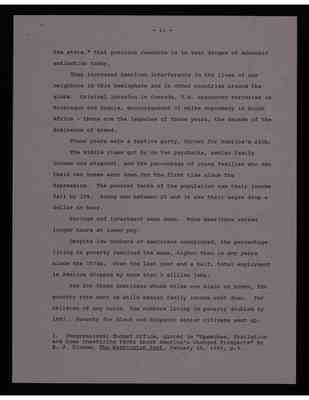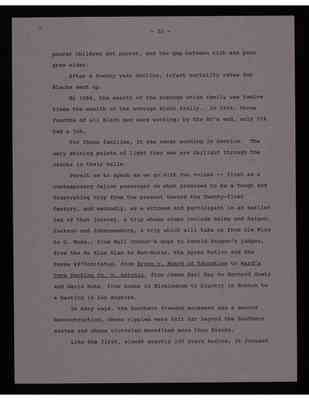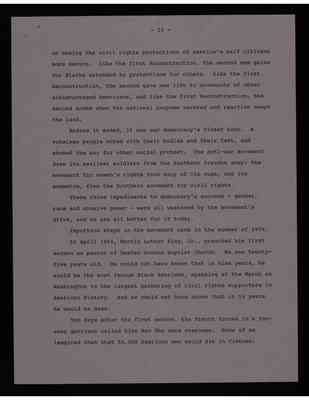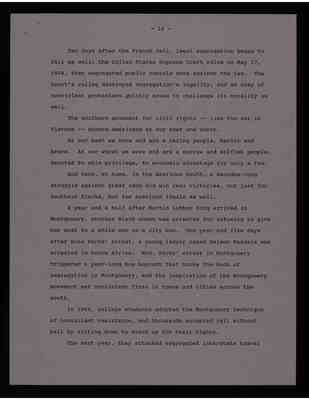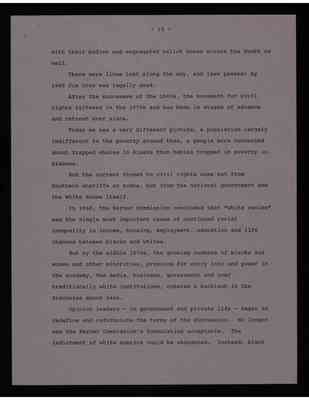Pages
11
11 the state," that precious resource is in real danger of economic extinction today.
They increased American interference in the lives of our neighbors in this hemisphere and in other countries around the globe. Criminal invasion in Grenada, U. S. sponsored terrorism in Nicaragua and Angola, encouragement of white supremacy in South Africa - these are the legacies of those years, the decade of the dominance of greed.
Those years were a festive party, thrown for Ameria's rich.
The middle class got by on two paychecks, median family income was stagnant, and the percentage of young families who own their own homes went down for the first time since the depression. The poorest tenth of the population saw their income fall by 10%. Young men between 25 and 34 saw their wages drop a dollar a hour.
Savings and investments were down. More Americans worked longer hours at lower pay.
Despite low numbers of Americans unemployed, the percentage living in poverty remained the same, higher than in any years since the 1970s. Over the last year and a half, total employment in America dropped by more than 3 million jobs.
And for those Americans whose skins are black or brown, the poverty rate went up while median family income went down. For children of any color, the numbers living in poverty doubled by 1987. Poverty for Black and Hispanic senior citizens went up.
1. Congressional Budget Office, quoted in "Speeches, Statistics and Some Unsettling Facts About Americ'a Changed Prospects" by E. J. Dionne, The Wahington Post. January 2, 1992, p. 3.
12
12 poorer children got poorer, and the gap between rich and poor grew wider.
After a twenty year decline, infant morality rates for Blacks went up.
By 1988, the wealth of the average white family was twelve times the wealth of the average Black family. In 1969, three fourths of all Black men were working; by the 80s end, only 57% had a job.
For these families, it was never morning in America. The only shining points of light they see are daylight through the cracks in their walls.
Permit me to speak as we go with two voices -- first as a contemporary fellow passenger on what promises to be a tough and frustrating trip from the present toward the Twenty-first Century, and secondly, as a witness and participant in an earlier leg of that journey, a trip whose stops include Selma and Saigon, Jackson and Johannesburg, a trip which will take us from Ole Miss to U. Mass., from Bull Connor's dogs to Ronald Reagan's judges, from the Ku Klux Klan to Neo-Nazis, the Ayran Nation and the Posse ##?Comitatus, from Brown v. Board of Education to Ward's Cove Packing Co. v. Antonio, from James Earl Ray to Bernard Goetz and David Duke, from bombs in Birmingham to bigotry in Boston to a beating in Los Angeles.
In many ways, the Southern freedom movement was a second Reconstruction, whose ripples were felt far beyond the Southern states and whose victories benefited more than Blacks.
Like the first, almost exactly 100 years before, it focused
13
13 on making the civil rights protections of America's half citizens more secure. Like the first Reconstruction, the second saw gains for Blacks extended to protections for others. Like the first Reconstruction, the second gave new life to movements of other disadvantaged Americans, and like the first Reconstruction, the second ended when the national purpose wavered and reaction swept the land.
Before it ended, it was our democracy's finest hour. A voteless people voted with their bodies and their feet, and showed the way for other social protest. The anti-war movement drew its earliest soldiers from the Southern freedom army; the movement for women's rights took many of its cues, and its momentum, from the Southern movement for civil rights.
These three impediments to democracy's success - gender, race and abusive power - were all weakened by the movement's drive, and we are all better for it today.
Important steps in the movement came in the summer of 1954.
In April 1954, Martin Luther King, Jr., preached his first sermon as pastor of Dexter Avenue Baptist Church. He was twenty - five years old. He could not have known that in nine years, he would be the most famous Black American, speaking at the March on Washington to the largest gathering of civil rights supporters in American History. And he could not have known that in 14 years he would be dead.
Ten days after the first sermon, the French forces in a far-away garrison called Dien Ben Phu were overcome. None of us imagined then that 55,000 American men would die in Vietnam.
14
14 The days after the French fell, legal segregation began to fall as well; the United States Supreme Court ruled on May 17, 1954, that segregated public schools were against the law. The Court's ruling destroyed segregation's legality, and an army of nonviolent protestors quickly arose to challenge its morality as well.
The southern movement for civil rights - - like the war in Vietnam - - showed Americans at our best and worst.
At our best we were and are a caring people, heroic and brave. At our worst we were and are a narrow and selfish people, devoted to skin privilege, to economic advantage for only a few.
And here, at home, in the American South, a decades-long struggle against great odds did win real victories, not just for Southern Blacks, but for American ideals as well.
A year and a half after Martin Luther King arrived in Montgomery, another Black woman was arrested for refusing to give her seat to a white man on a city bus. One year and five days after Rosa Parks' arrest, a young lawyer named Nelson Mandela was arrested in South Africa. Mrs. Parks' arrest in Montgomery triggered a year-long bus boycott that broke the back of segregation in Montgomery, and the inspiration of the Montgomery movement set nonviolent fires in towns and cities across the south.
In 1960, college students adopted the Montgomery technique of nonviolent resistance, and thousands accepted jail without bail by sitting down to stand up for their rights.
The next year, they attacked segregated interstate travel
15
15
with their bodies and segregated ballot boxes across the South as well.
There were lives lost along the way, and laws passed; by 1965 Jim Crow was legally dead.
After the successes of the 1960s, the movement for civil rights faltered in the 1970s and has been in stages of advance and retreat ever since.
Today we see a very different picture, a population largely indifferent to the poverty around them, a people more concerned about trapped whales in Alaska than babies trapped in poverty in Alabama.
But the current threat to civil rights came not from Southern sheriffs or bombs, but from the national government and the White House itself.
In 1968, the Kerner Commission concluced that "white racism" was the single most important cause of continued racial inequality in income, housing, employment, education and life chances between blacks and whites.
But by the middle 1970s, the growing numbers of blacks and women and other minorities, pressing for entry into and power in the academy, the media, business, government and over traditionally white institutions, created a backlash in the discourse about race.
Opinion leaders - in government and private life - began to redefine and reformulate the terms of the discussion. No longer was the Kerner Commission's formulation acceptable. The indictment of white America could be abandoned. Instead, black
